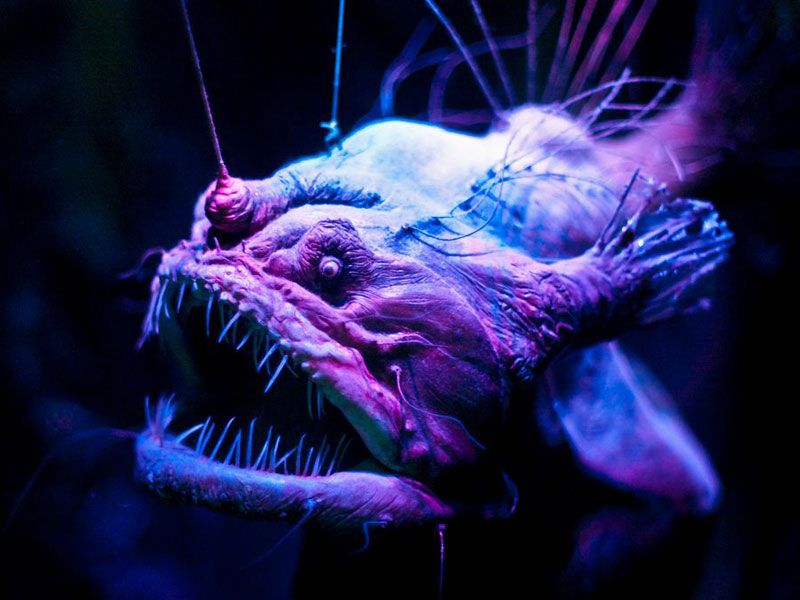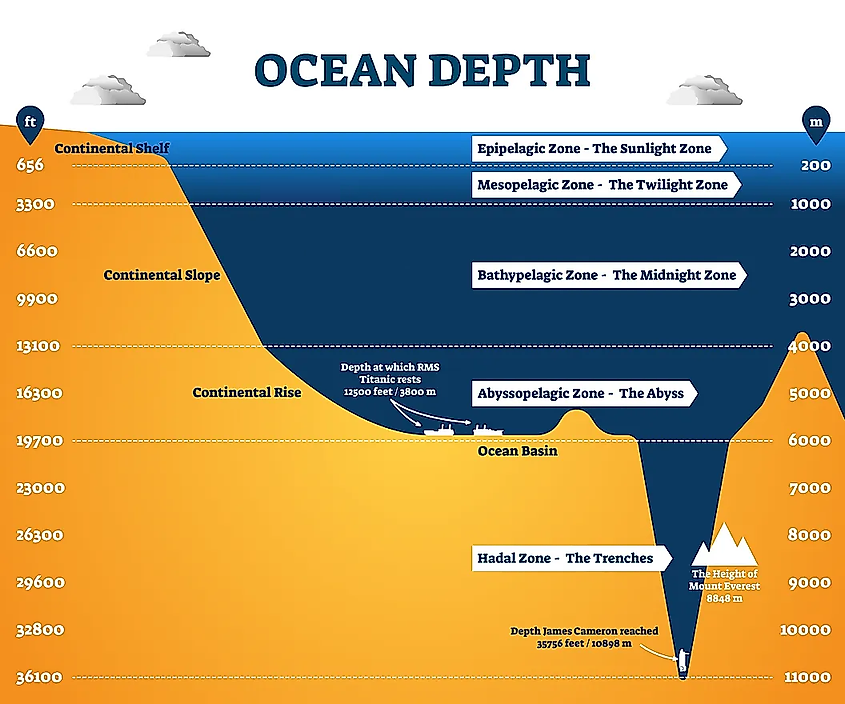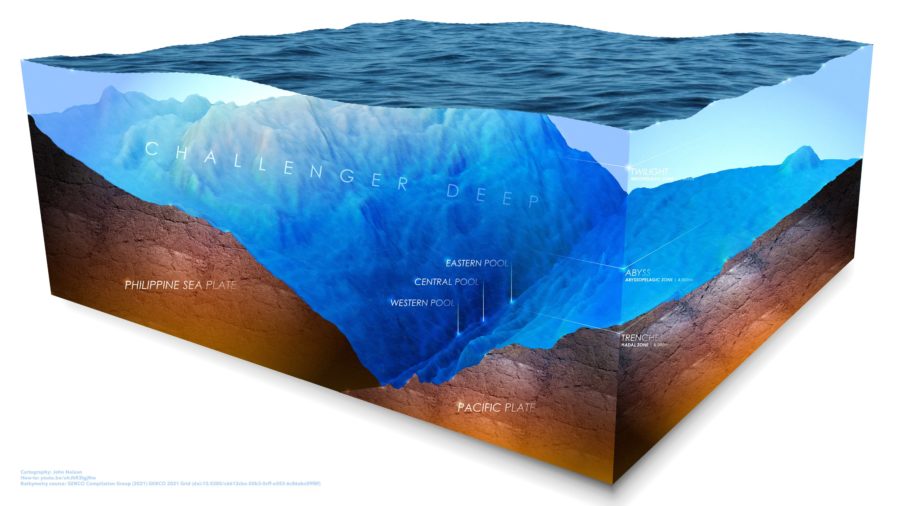The deepest place in the ocean has been mostly unknown to scientists until recently
The deepest of all water covered places on earth is seven miles under the surface
So what’s down there?
The following written content from Nathaniel Whelan

With an average depth of 3,700 meters, experts have also divided the world ocean into various zones based on depth from the surface for ease of oceanographic studies. The sunlight zone, twilight zone, and deep ocean are the three major zones of the ocean.
The deep ocean is further divided into 3 layers which are the midnight zone, the abyss and the trenches.
With an average depth of 3,700 meters, experts have also divided the world ocean into various zones based on depth from the surface for ease of oceanographic studies. The ocean is divided into zones depending on how far light reaches:
Ocean Sunlight Zone
Aptly named for its position at the surface level, this sunlight zone, also called the surface zone or epipelagic zone, extends downward 200 meters or roughly 5% of the ocean’s average depth. At midday, it is practically fully lit by the sun, hence called the sunlight zone. It is also regarded as the warmest layer. An abundance of natural light also generates heat, which penetrates deeper waters due to the movement of the wind.

Depending on location, the temperature of the epipelagic zone can go as high as 97 degrees Fahrenheit or drop as far 28 degrees.Enough sunlight penetrates this layer for algae to utilize photosynthesis, which in turn creates roughly 50% of the oxygen in our atmosphere. The surface zone is where the majority of commercial fishing takes place and is home to many kinds of animals, including whales, dolphins, and sharks, many of whom frequently break the ocean’s surface.
Ocean Twilight Zone
The twilight zone or the mesopelagic zone begins at 200 meters and extends downward to 1,000 meters, making up approximately 20% percent of the ocean’s total depth. It is generally a very dim region, but it does receive a sliver of sunlight at the midday point which is enough for photosynthesis to occur. The twilight zone actually plays a large role in regulating our planet; the ocean absorbs roughly 25% of the carbon dioxide humans emit and pushes it down to the deep ocean, preventing it from rereleasing into the atmosphere.

Unlike the surface zone, this second layer has remained relatively untouched from commercial fishing despite the fact that it is bursting with aquatic life. The mesopelagic zone is also where experts have first noted the existence of bioluminescent creatures. Temperature changes here are the most extreme. This is in part due to the thermocline, a transitional region where warmer water decreases rapidly.
The Deep Ocean
The deep ocean—the third and final layer—extends from the 1,000 meter point to the ocean floor, regardless of how deep that is. At minimum, it makes up 75% of the ocean’s depth. It is a frigid region that receives absolutely no natural light. The organisms that live in this zone are bioluminescent; that is to say they produce and emit their own light.
Examples of these creatures include certain types of plankton, jellyfish, squid, and the nightmarish barbeled dragonfish. Living in complete darkness, they have light-sensitive eyes that allow them to sense each other’s presence. The deep ocean is further divided into 3 zones: Midnight zone, the Abyss and the Trenches
Ocean Midnight Zone
The midnight zone is also known as the bathypelagic zone makes up the first third of the deep ocean in the three layers model. It extends downward from 1,000 meters to 4,000—roughly the average depth of the global ocean. The temperature rarely changes, remaining at a fairly consistent 39 degrees Fahrenheit. As mentioned earlier, the only light in this regions does not come from the sun, but from bioluminescent animals who use their ability to hunt or find a mate. Some go for days living in complete darkness. However, there are a few sea creatures who swim this far down to feed, such as sperm whales. In fact, being fifteen times the size of the epipelagic zone, the bathypelagic is generally regarded as the world’s largest ecosystem.
The Abyss
The abyss (abyssopelagic zone) is the middle layer of the deep ocean. Its name comes from the Greek word abyss which means “no bottom.” True to its name, there was a time when the ancients believed that the ocean was a bottomless void. It extends from 4,000 meters down to 6,000, which for some global regions marks the seafloor. The water temperature never rises above near freezing. There is a startling lack of life in the abyssopelagic zone; only a select few creatures can survive the immense pressure, such as invertebrates.
The Trenches
The trenches (hadalpelagic zone) is the deepest part of the ocean. It extends past the abyssopelagic zone in parts of the world where that is physically possible; this is usually in the form of deep sea trenches and canyons. An example of such a marvel is the Mariana Trench in the Pacific Ocean, which marks the deepest location on Earth at 11,034 meters, a depth so deep that Mount Everest would be completely submerged if placed at the bottom. The pressure is so intense that it equates to the approximate weight of 48 Boeing 747 jets. Even so, life does exist in this zone. The abyssobrotula galatheae—a species of eel—was discovered at 8,372 meters in the Puerto Rico Trench in 1970.
Providing Better Insight
The ocean is a vast expanse of water that covers more of the Earth’s surface than land. Regardless, expert oceanographers have managed to divide it up into various layers. While there is crossover between the three and five layers concepts, particularly within the first two layers, this article has examined the unique characteristics of each zone. The ocean remains one of the most mysterious places on our tiny blue planet, but breakdowns such as this help provide better insight into its awe-inspiring wonder. Read more from Worldatlas

The following written content from Geoffrey Migiro
The deepest region of the earth’s ocean is the Challenger Deep. Situated on the floor of the Pacific Ocean, this is a valley on the southern part of the Mariana Trench. Mariana Trench is a 43 mi broad crescent-shaped region on the floor of the Pacific Ocean. The Challenger Deep has a depth of approximately 36,070 ft (with an error of +/-130 ft).
Mariana Trench
The Mariana Trench is situated at the boundary of two converging plates, where two oceanic lithosphere plates collided resulting in one of them descending into the Earth’s mantle. Ocean trenches form some of the most profound valleys on the ocean. An ocean trench is a downward flexure that is formed at the boundary where two lithosphere plates collided.
Exploring The Challenger Deep
Don Walsh and Jacques Piccard were the first individuals to explore this part of the ocean in 1960. Using the Trieste Bathyscaphe, they descended to about 35,814ft. Researchers from Wood-hole oceanographic institute finished the deepest dive in 2009. With a robotic vessel known as Nereus, these researchers attained a depth of approximately 35,767ft. Unlike Kaiko, the Japanese robotic vehicle sent to the Marinas trench in 1998, Nereus was not controlled or powered by a cable which linked it to the mother-ship, and it sent live data to the ship. The latest exploration was by the Haidou, a Chinese vessel, on May 23, 2016, and it attained a depth of about 35,325ft.
Earthquakes At The Marina Trench
The trench formed at the plate boundary between the Pacific and the Philippines lithosphere plates. Although they both move towards the northwest, the velocity of the Pacific was higher than the speed of the Philippines plate. Recurrent earthquakes occur on the boundary since the descent of the Pacific plate into the earth’s mantle is neither uniform nor smooth. As the Pacific plate moves towards the mantle, it is heated by geothermal gradient and friction. Minerals melt from the rocks, and this produces magma which floats towards the surface. As the magma ascends to the top, volcanic eruptions occur.
Life Forms At The Challenger Deep
The report by the HMS Challenger expedition reported two species of radiolarian when they discovered in the Challenger Deep. The radiolarians (Spumellaria and Nassellaria) were published in 1887 by Ernst Haeckel. The camera on the Kaiko probe recorded a shrimp, scale worm, and sea cucumber. Nereus probe sighted an inch long Polychaete-worm at the bottom of the Challenger Deep. Read more from Worldatlas





